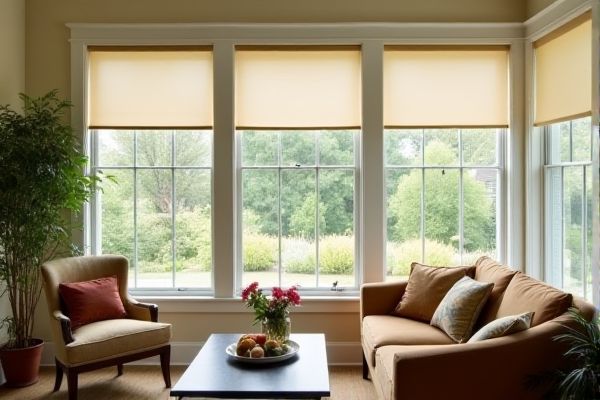
Roller shades offer a sleek, minimalist look and easy operation, while cellular shades provide superior insulation and energy efficiency for your sunroom by trapping air in their honeycomb cells. Discover which option best suits your sunroom's style and comfort needs by exploring the rest of this article.
Table of Comparison
| Feature | Roller Shades | Cellular Shades |
|---|---|---|
| Light Control | Good, solid fabric blocks direct sunlight | Excellent, honeycomb design diffuses light softly |
| Energy Efficiency | Moderate insulation | High insulation, reduces heat loss in sunrooms |
| Privacy | Provides basic privacy | Superior privacy with cellular layers |
| Aesthetic | Sleek and minimalistic | Textured with dimensional appeal |
| Durability in Sunroom | Good, but can fade under direct sun | Excellent, designed to withstand temperature changes |
| Installation | Simple, mounts inside or outside window frame | More complex, may need professional installation |
| Cost | Affordable | Higher initial investment |
| Maintenance | Easy to clean with damp cloth | Requires gentle cleaning to maintain cells |
Introduction to Sunroom Window Treatments
Sunroom window treatments like roller shades and cellular shades provide essential light control and energy efficiency. Roller shades offer a sleek, minimalist design that easily adjusts light levels, while cellular shades feature a honeycomb structure that enhances insulation and temperature regulation in your sunroom. Choosing the right option depends on your preference for style, privacy, and energy savings.
What Are Roller Shades?
Roller shades are window coverings made from a single piece of fabric that rolls up neatly on a cylindrical tube when raised, providing a clean and minimalist look ideal for sunrooms. They offer excellent light control and UV protection, helping to reduce glare while maintaining an unobstructed view when fully opened. Unlike cellular shades, roller shades have a smooth surface without cellular honeycomb construction, making them easier to clean and better suited for humid sunroom environments.
What Are Cellular Shades?
Cellular shades, also known as honeycomb shades, are window coverings designed with a unique cellular structure that traps air, providing excellent insulation and energy efficiency. In a sunroom, cellular shades help regulate temperature by reducing heat gain in summer and heat loss in winter, enhancing comfort and lowering energy costs. Choosing cellular shades for your sunroom offers the dual benefits of light control and improved thermal performance compared to standard roller shades.
Light Control: Roller vs Cellular Shades
Roller shades offer precise light control by smoothly rolling up or down, allowing you to adjust sunlight levels with ease in your sunroom. Cellular shades provide superior insulation and diffuse light softly through their honeycomb structure, reducing glare while maintaining brightness. Your choice depends on whether you prioritize sleek, direct light adjustment or enhanced energy efficiency and soft light diffusion.
Energy Efficiency Comparison
Cellular shades provide superior energy efficiency in sunrooms due to their honeycomb structure, which traps air and creates insulation that reduces heat transfer by up to 30%. Roller shades offer minimal insulation, primarily serving as light blockers rather than thermal barriers. Choosing cellular shades can lead to significant energy savings by maintaining temperature control and reducing HVAC costs.
Privacy Options in Sunrooms
Roller shades offer sleek, minimalistic privacy with various opacity levels, allowing you to control light while maintaining a modern look in your sunroom. Cellular shades provide superior insulation and enhanced privacy thanks to their honeycomb structure, which diffuses light and obstructs visibility from outside. Your choice depends on whether you prioritize a streamlined aesthetic or maximum privacy and energy efficiency in your sunroom.
Style and Aesthetic Appeal
Roller shades in a sunroom offer a sleek, minimalist look with smooth, clean lines that complement modern and contemporary decor styles. Cellular shades provide a textured, dimensional appearance with honeycomb cells that enhance insulation while adding a cozy, layered aesthetic ideal for creating a warm, inviting atmosphere. Both options allow for customizable light control and color choices, but cellular shades excel in combining functionality with a soft, architectural design element.
Installation and Maintenance
Roller shades offer straightforward installation with minimal hardware, making them suitable for DIY projects in your sunroom, while cellular shades require precise measurement and professional installation to ensure proper fit and insulation. Maintenance for roller shades is simple, involving occasional dusting and spot cleaning, whereas cellular shades need gentle vacuuming with a brush attachment to prevent damage to their honeycomb cells. Choosing between these options depends on your preference for ease of setup versus enhanced thermal performance and upkeep.
Cost Analysis
Roller shades generally offer a more budget-friendly option for sunroom window treatments, with prices ranging from $20 to $100 per shade depending on size and fabric. Cellular shades tend to be more expensive, typically costing between $50 and $200, due to their honeycomb design which provides superior insulation and energy efficiency. For your sunroom, choosing cellular shades may result in higher upfront costs but could lead to long-term savings on heating and cooling bills.
Choosing the Best Shade for Your Sunroom
Roller shades provide a sleek, modern look with easy operation and excellent light control, ideal for sunrooms requiring simple, unobtrusive window treatments. Cellular shades offer superior insulation with their honeycomb design, enhancing energy efficiency while softly diffusing sunlight to create a comfortable environment in sunrooms. Selecting the best shade depends on balancing factors such as desired light filtration, thermal performance, and aesthetic preferences to optimize comfort and style.
 homyna.com
homyna.com